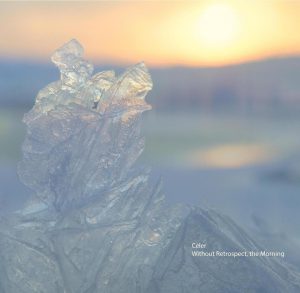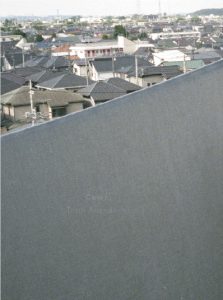“A few stories, put together with no previous purpose, than having their own place and time,” that is the conceptual story arc of Will Long’s aka Celer’s four-track anthology called I, Anatomy, released in September 2012 on former dada-musician Christoph Heemann’s Streamline label in a double-vinyl edition, with each side containing but one of the compositions. It is Heemann who also comes up with the artwork of the nocturnal fairytale-like castle depiction. Without a doubt, I, Anatomy is one of Will Long’s most important and personal works, as he is a twofold curator on this LP: firstly, he presents and singles out the wealth of material he co-wrote and assembled with his partner Danielle Baquet-Long who suddenly passed away in 2009. This activity makes him a curator in the most technical sense of the word. But he is also a curator of the soul-searching process whose strong omnipresence permeates through this release and culminates in a final pressing question during the last few seconds of the album. In an email to me, Long describes this work as a special album for him, and although the listener can never fully unravel all the memory-related layers or catch the flashing keepsake bursts, the term momentousness receives an expanded meaning. Since it is all about moments, the former duo of Celer surprise with the solemn, positively circumlocutory build-up, allowing the compositions to meander, making them seem like single tracks with one specific meaning rather than being comprised of several thought bubbles and much deeper experiences. And despite the context in which this album is released as well as its intradiegetic narration, it is astonishingly saturated, always soothing, uplifting and all in all colorful, merging the deepest depth and pristine purity of multiple wraithlike textures. Since I, Anatomy is an album akin to the Drone genre, the melodies are of course stretched and hardly hummable, but in tandem with the noteworthy textures and the synth creeks, this is one of the most euphonious – better still: euphoric – releases of this field. Its many ornaments, field recordings, plinking chimes and lack of New Age mannerisms make it an intriguing work of art. The first vinyl disc features two memory-laden, permanently oscillating and delightfully varied Ambient tracks, whereas the second disc includes the 2007 EP’s All At Once Is What Eternity Is and The Die That’s Caste, both of which Danielle and Will always intended to attach closely to each other. This plan has now come to fruition. I am reviewing the digital version given to me by Will Long.
I, Anatomy launches with the first series of episodes and incidents, or so it seems, as the verbose title of this 18-minute piece does not necessarily coincide with – or to use a more absolute term: explain – the unfolding stream of consciousness on side A. It seems that Will Long’s own short abstract about the many vignettes explicates the driving factor of this particular piece a lot better: “My friend, 103 years old, sat across the room from me, a small gas heater nearby, with photos of family and Martin Luther King, Jr., and we talked for a few hours in the late morning. I had brought him a plant a few years before, and planted it in the front yard, but it had died the winter before.” And indeed do the words of his old, erudite friend mark the beginning. The soft pink noise level and the room-related reverberation create a remarkable interdependence in adjacency to the transported meanings of the words. Oscillating between truly personal tales and universally eclectic words of insight, the first synth rivers float in after about 45 seconds, perfectly warm, wave-like and ecclesial, comprising of a deeply content, positive stream bed with bubbling sine waves and mellow chime ornaments whirring around this nexus. There is no dolefulness, no injection of sorrow, and though the synth waves are unexpectedly loop-like for a Celer track, the ensuing fade-out phase with a newly occurring propulsion make this passage work due to its cherubic characteristic. It is hard to explain, but despite the ethereality and depth, everything feels lofty; despite the plinking particles, warmth is everything there is. The same textures reappear later in a reorganized melody, with a beautiful string-like timbre and trembling accentuations. This beautiful mélange is equally pompous, but tremendously uplifting. There are no hidden undertones of gloom, as everything feels ecstatic, overexposed and yet mesmeric. This silky path leads to a bustling field recording of children, which itself is replaced with the first proper Drone setup of a gelid-mechanical monotony. After a continuation of the afore-running field recording, the mirroring scheme and the track itself are completed with a second drone infusion which is much warmer and more entrancing than the frostier breeze. Side A succeeds with its enormously welcoming and encapsulating atmosphere of bliss and thermal heat, and even the curious wave of coldness placed near its end cannot break the intrinsic mood of blithesomeness.
Side B opens with an analogical string of incidents and memories. The inspiration of this arrangement of 19 minutes is refreshingly mundane and common. Celer tells: “A carnival in Costa Mesa, California. Kids screaming on the rollercoasters, the sound of balloons popping, machinery spinning, with smells of beer and popcorn all over the ground.” And indeed does the first vignette contain the archetypical concoction of noises you might expect, shrieking children, the intriguingly soft whoosh of the distant fairground rides and a buzzing siren’s wailing. The duo of Celer unleashes another warm string-like melody shortly thereafter, and its quavering traits and the celestial brightness even increase the outright gleesome ebullience found on side A. At one point, the melody is pitched down a few notes all of a sudden, creating the wonderful analog effect of a wobbling tape without ever destroying the celebratory ambience that is in the air. The mood is decidedly decoupled from the carnival setting, the listener is floating in Elysian realms way above the rollercoaster and is yet plainly placed on the ground. Once this vignette fades out slowly, the listener returns to the fairground as an old steel pan-accentuated movie sample unfolds. I did not link Will Long’s project to cruddy outcries of excitement à la “dope!“ or “rad!” heretofore, but this short intersection is creative, unexpected and fitting in the given overarching scheme! The consecutive fragment is especially echoey and dreamlike, for it consists of many sustain phases that conflate with the darkness, a snugly woman or child singing in the backdrop, and soothing waves of symphonic warmth. I do not know how Will and Danielle accomplished this languorous mirage: is it Danielle singing? Has a well-known song been processed beyond recognition and then extended with magnanimous amounts of hall effects? It provides a magical, dreamlike state, and as such should not been demystified. The final part is particularly seraphic; a cathedral of the mind is aurally painted via huge boosts of reverb, slow churchly organ notes, galactic fiddles and a cave-like atmosphere. With this contemplative, magnificently bolstered state intact, the song fades out, ending the first vinyl disc with a transfigured kind of happiness.
The second vinyl presents two of the duo’s EP’s of 2007 and make an important heartfelt wish of Danielle and Will come true: they always wanted to couple both works on one album, but since they were then released on different labels, this endeavor proved to be impossible afterwards. Fulfilling Baquet-Long’s wish posthumously, side A features the EP called All At Once Is What Eternity Is, whereas side B is solely reserved for The Die That’s Caste. It is here that I, Anatomy changes its narratological style, as the two EP’s do not present a string of multiple events; if they do, it is realized in an implicit manner via the mode of action of the sound layers, not the titles themselves. All At Once Is What Eternity Is, originally released on the French Taâlem label, opens its almost 23 minutesin medias res, with a moon-lit swamp atmosphere thanks to its cricket-like chimes, whispering vesicles and intense synth washes that are occasionally slightly cacophonous and even portentous, but always find their way back to more auroral airflows. It becomes clear right from the get-go that the intermixture of the synth strings and drones is not as epicurean. Gossamer acroamatic undertones of tension are carefully interwoven, potentially counteracting against a too bright incandescence, always looming and reaching their peak the same time the wave-like climax does. After the inclusion of a few field recordings of pops and crackles, the synths come back to full force, now a bit more limewashed and blurry. Once another field recording of gentle ocean waves is admixed, the scenery brightens up with the drone layers reciprocating ecstatic warmth and cavernous insinuations in equipollent parts, resulting in a whale song-like structure embedded in-between an orchestra string arrangement analogical to John Adams. The complexity of this EP does not kill the accessibility to this tune, but it becomes apparent that the vivacious colorscapes of the first vinyl disc are now neglected for a scheme that is nurtured by potentially conflicting keys.
I, Anatomy finishes with The Die That’s Caste, an EP of 17 and a half minutes originally released on the Spanish Conv label. Although Will Long is not too keen on the genre description called Drone, it is a tremendously fitting term for this EP since Celer augment the plasticity with a bold dose of abyssal bass drones in proximity to a particularly glacial output, making it the duo’s most coherent offering of the double LP. The point of departure already features a slow fade-in of heavily fluttering brazen creeks in the veins of Francisco López, and it is equally hard to pinpoint a specific mood; it is by no means frightening rather than strangely soothing due to its belly-massaging characteristic trait, the gradual annexation of crystalline wind gusts and a deepened sine wave. Each of the layers seems to be either winterly and thin or cloudy and blurry, but in tandem they create a tremendously misty and mollifying panorama of light grey tones and purified white sprinkles. The state of loneliness, majesty and a lachrymose rumination transcends perfectly and is elevated to towering spheres on this composition. The wave-like interplay is harder to detect this time, as The Die That’s Caste does not feature a lacunar structure. Whenever a layer ebbs, there are many other streams and strings that cover the accruing fissure. Near the end of the album, the bass drones are resurrected, a more mechanical sine wave-perturbed setting is erected and finished off with an essential question which each of us has been asked at a certain time in our lives, and answering it in a reflected and thoroughly honest manner is as impossible for us in that certain moment as it is distressing afterwards: “What are you running away from?” I, Anatomy is stuck for an answer.
Danielle Baquet-Long’s and Will Long’s audio diary called I, Anatomy has finally been realized in a beautiful form and with great style. Since Will is still curating the unreleased material he has co-written with Danielle, the enablement of such luxurious and limited releases does not solely depend on the respective label anymore, but the curative skills and the ability to weave a bearing around the presented material. As I have stated in this review, the concept of depicting a few incidents that do not have much in common other than the fact that all of them are heartwarming and precious, is a straightforward and honest one. And the music entrances the listener and does not only live up to the modest implications set by Celer, but exceeds the unveiled prospects by a wide margin. The first two tracks are tremendously vivid and varied, with field recordings following after lush drone thickets. I cannot help myself but to note the Rave-related structure: naturally, one won’t hear pitched voices or eclectic Jungle snare drums in a Celer tune, but the synths themselves sound so vibrant, fresh and crunchy that they would in a weirdly twisted way resemble the late 80’s and early 90’s halcyon days and the second Summer of Love in Britain if they were sped up. This is Drone music of the heart, and yet it gleams and shines in technicolor. The second vinyl disc couples the two important 2007 EP’s, and it is here that the mood is getting more doleful without ever being soul-crushing or crestfallen.All At Once Is What Eternity Is provides a specifically detailed glance onto the counteracting, ambiguous setup of opposite moods and strings, as the duo of Celer skillfully mediates between them and brews a brightly-lit result, whereas The Die That’s Caste offers a stringent take on hibernal synthscapes with piercing sine waves and a crystalline mist, making it the most contemplative and profound composition whose implied colors stand in a contrastive relation to Christoph Heemann’s LP artwork. I, Anatomy is as ever-changing and fluctuant as the delineated memories one has in mind, but can never grab them in deeper clarity. The strongly positive vibe on the majority of the offered material is the album’s biggest boon, followed by the saturated textures and the variety.
Link


